Simon and Kirby produced crime comics during two periods; for Prize and Hillman (1947 to 1951) and for their own publishing company Mainline (1954 to 1955). Perhaps the genre was already in decline but after the introduction of the Comic Code crime comics all but disappeared. I know that Justice Traps the Guilty continued to be published until 1958, but were there any other crime comics that lasted long under the Comic Code? It would seem that crime was pretty much a forgotten comic genre until Jack Kirby did In the Days of the Mob for DC in 1971.
Was In the Days of the Mob ahead of its time, another example of Kirby’s visionary genius? It, and the sister publication Spirit World, were very different than all the other comics released at the time. Different in size and printing. Not the normal comic book size but that of a magazine. And not the normal comic book coloring but all with tones of black. Mark Evanier, an assistant to Jack at that time, has said that it was Kirby’s idea to produce a more adult oriented comic. The magazine size therefore makes sense since it would allow the title to escape the Comic Code censorship. Which was clearly necessary if the stories were going to be anything stronger than the mild superhero comics that dominated the industry at that time. Evanier has also said that Kirby’s intentions were that In the Days of the Mob would be printed in color and that the gray wash that the magazine was subjected to was DC’s idea. It certainly seems like a visionary idea since In the Days of the Mob was years ahead of Heavy Metal (first appearing in 1977) another magazine size comic for a more adult audience.
But what about the stories? Was Kirby looking at the future there as well? Right away the reader is presented with Warden Fry, warden of Hell. Fry will introduce the stories and provide a link between each. Using a character as a spokesperson for a comic had been done before but perhaps not always so well as In the Days of the Mob. The interior is largely one long graphic sequence. Page numbering is for the entire magazine and not for the individual stories. Only the splash pages give notice of the start of the next tale. This is a magazine meant to be read in the order that it is produced.
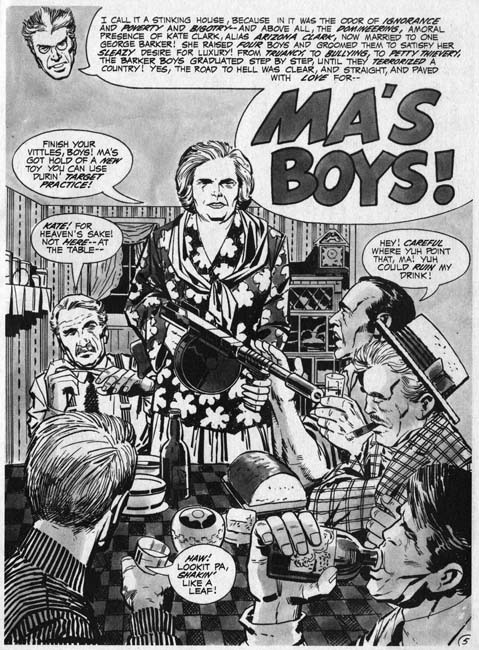
In the Days of the Mob (Fall 1971) “Ma’s Boys”, pencils by Jack Kirby inks by Vince Colletta
The first story is “Ma’s Boys” a tale of Ma Barker and her criminal sons. Jack had told this story before, or more accurately Simon and Kirby had. “Mother of Crime” had appeared in Real Clue Crime Stories (volume 2 number 4, June 1947). I have briefly discussed it before (Crime’s Better Half) and it was include in Titan’s “The Best of Simon and Kirby”. Since these stories are supposed to be real, it would not come as much of a surprise that there are similarities between the old and the newer versions of the story. But actually it is obvious that there is much more than a casual connection between the two because in the Simon and Kirby version Ma Barker relates her story from hell. Undoubtedly in 1971 Jack’s inspiration came from the Simon and Kirby story. He not only retold the story he expanded the use of hell from this single story to become a theme for the entire magazine.
The story of Ma Barker as gang leader may have been fiction but one that did not originate from Simon and Kirby. While Ma traveled with the gang, surviving members insisted she took no part in the planning or executing the crimes. They claimed that such matters were not even discussed in her presence. It was said that the story was fabricated to protect the public image of the FBI after it was found that they had killed an elderly mother.
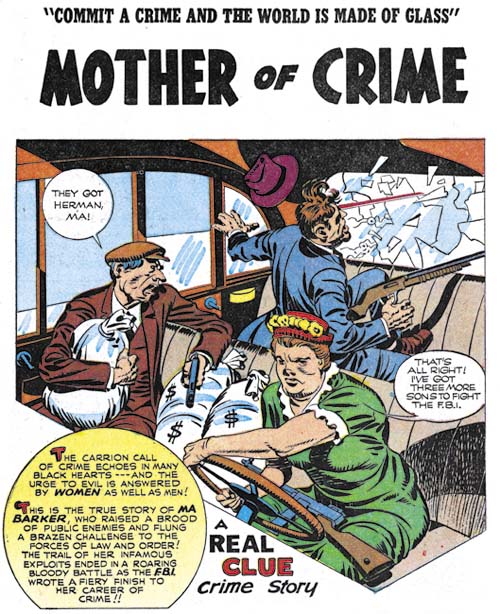
Real Clue Crime Stories v. 2 n. 4 (June 1947) “Mother of Crime”, pencils and inks by Jack Kirby

In the Days of the Mob (Fall 1971) “Bullets for Big Al”, pencils by Jack Kirby inks by Vince Colletta
The next story from In the Days of the Mob is about Al Capone. It turns out that Simon and Kirby had done a story about Capone as well called “The Case Against Scarface” (Justice Traps the Guilty #1, October 1947). However the story that Jack did for In the Days of the Mob is not the same one covered by Simon and Kirby. So while the older story might have gotten his creative juices flowing, Jack ended up with an entire new tale. By the way “The Case Against Scarface” also appears in “The Best of Simon and Kirby”.

Justice Traps the Guilty #1 (October 1947) “The Case Against Scarface”, pencils and inks by Jack Kirby
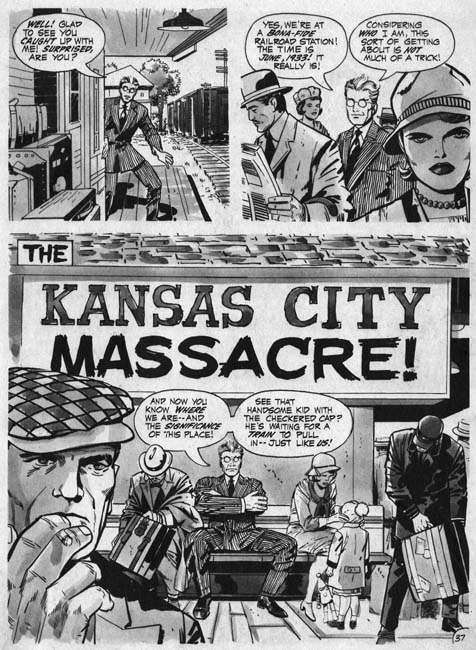
In the Days of the Mob (Fall 1971) “The Kansas City Massacre”, pencils by Jack Kirby inks by Vince Colletta
The third story, “The Kansas City Massacre”, was also one covered by Simon and Kirby (“The Strange Aftermath of the Kansas City Massacre”, Headline #26, September 1947). Solo Kirby concentrated on the massacre itself while Simon and Kirby covered that and also the events that followed. Kirby’s later version went in more detail than what was done earlier by Simon and Kirby but basically it is the same story.
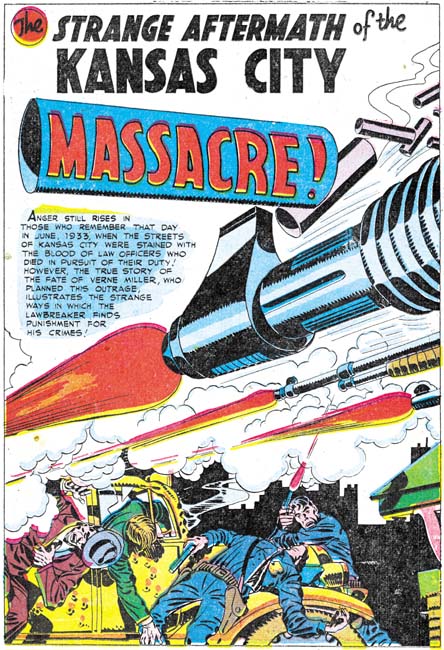
Headline #26 (September 1947) “The Strange Aftermath of the Kansas City Massacre”, pencils and inks by Jack Kirby
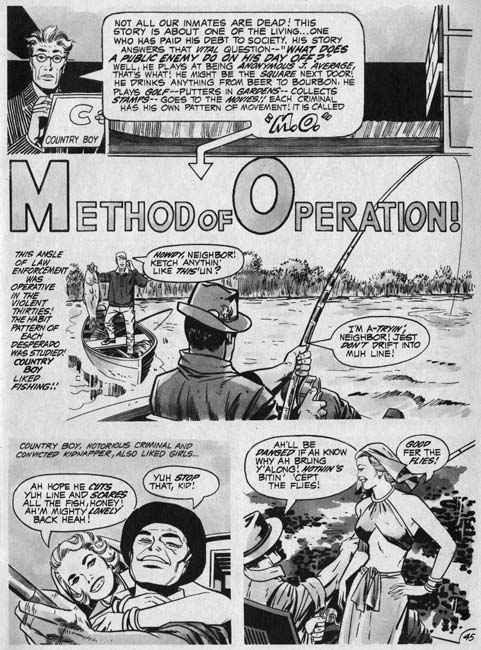
In the Days of the Mob (Fall 1971) “Method of Operation”, pencils by Jack Kirby inks by Vince Colletta
The final story that Kirby did for In the Days of the Mob was an unusual one called “Method of Operation”. The story is about a gangster whose fondness for fishing leads to his arrest by the head of the FBI, J. Edgar Hoover himself. The oddest thing about the story is Jack refers to the criminal as “country boy” and nowhere does Kirby actually identify him. However there is no doubt that country boy was Alvin Karpis. By this point it should come as no surprise that Simon and Kirby had previously done a story called “The True Life Story of Alvin Karpis” (Justice Traps the Guilty #2, December 1947).
The official story is that J. Edgar Hoover did in fact arrest Karpis, grabbing Karpis before he was able to get a rifle from the back seat. However Karpis claimed that Hoover never appeared until the FBI agents already had him safely in custody. However the fact that the car Karpis was driving did not have a back seat certainly casts doubt on the FBI version of the story. Of course this awkward detail never made it into either the Simon and Kirby or the solo Kirby stories.

Justice Traps the Guilty #2 (December 1947) “The True Life Story of Alvin Karpis”, pencils by Jack Kirby
It seems clear that with In the Days of the Mob Jack Kirby was looking back to when he was collaborating with Joe Simon. This is not at all surprising. Kirby came to work for DC because he did not receive the credit he felt he deserved during his time at Marvel. Further Kirby was unhappy with the changes that Stan Lee would impose on some of his creations. Kirby sought and obtained from DC a greater control over what he produced. The sort of control he had while he was collaborating with Simon. So it was natural for Kirby to think about and use as inspiration some of the more successful Simon and Kirby efforts. That is not to say that In the Days of the Mob were just a repeat of the Simon and Kirby crime comics. None of the specific text or imagery for Kirby’s crime magazine appears to have been lifted from the earlier Simon and Kirby efforts. Kirby completely redid the stories to fit his 70’s vision of how comics should be done. His art is full of impact. As for his writing, well let us just admit that his scripting was not, as still is not, universally admired. With In the Days of the Mob, Jack Kirby was both a visionary looking forward to a new market and a reactionary looking back on successful early creations. What Kirby was not, in this case, a man of his time. DC did not know what to do with Kirby’s new crime magazine and had no faith in it at all. The title was cancelled before the second issue was ever printed.
In closing I would like to add a note about the inking of In the Days of the Mob. Vince Colletta has been criticized, quite rightly in my opinion, for the liberties he took in erasing pencils in order to speed up inking. However Colletta’s inking in this title seems very solid and not at all overbearing. I like it very much. Which is more than I can say about the final ink wash used.
Tom Field has written about In the Days of the Mob as well (Jack Kirby Collector #16). Also Bob has covered it in The Jack Kirby Comics Weblog.


The Kirby mags were physically insignificantly different than the Warren and Skywald mags of the time — and far more like them than Heavy Metal in any way. It was beautiful how Kirby went to DC with so much hope. Apparently so quickly crushed. And now that I think about it: All the ideas he kept back from Marvel (understandably!), other than the 4th World stuff, nothing. And to put that in context: Yes, it’s full of new characters but few fully developed… many just toss-offs….
The magazine format, ink washes and slightly more mature material with a narrative host is definetly in line with the magazine comics being printed by Warren and Skywald, both published outside the CCA during the same time period. It’s interesting to see Kirby’s attempt, but I wonder if there would really have been enough variety of material to sustain the line and maintain reader interest within such a narrow genre. The horror mags could include western, historical, psychological, scifi etc within horror, but I don’t see ITDOTM being able to do something similar (then again, with only one issue printed, I guess it’s a little hard to know for sure where Kirby might have taken it, right?).
I was not comparing the publishing method or appearance but the audience. I consider magazines like Hell-Rider or Vampirella as aimed at a young audience just like the standard comics were. Mad also used the magazine format to avoid the Comic Code and that does not mean it was aimed at a more adult audience either.
I also wrote an article about In The Days of the Mob for Jack Kirby Quarterly # 15. I quite enjoyed both Kirby magazines when they came out in 1971 and would have liked to see his progess on an ongoing basis. Kirby was always attracted to stories involving crime figures, and they continued to show up even in his super hero stories, from New Gods to the Black Panther. In my opinion the black and white format worked for the crime and horror stories, although it would have been interesting to see what Kirby would have accomplished on better paper and a varied palette. In my article I also commented on Colletta’s solid work on this book. He seems to have been inspired by the pencils and it is one of his best inking jobs.
I did not leave your article out on purpose but unfortunately it did not come out in my Google searches.
I think In The Days Of The Mob is some of Kirbys absolute best work!
I don’t like Colletta’s inking, seeing the fantastic job Mike Royer did on Vol II, he should of done them both. Speaking of Vol II, anyone on Earth know where it can be found!
DC should really do the omnibus treatment for this fantastic Kirby work?
Thanks for highlighting this often-forgotten chapter in Kirby’s output. This article encouraged me to look for digital copies, which eventually turned up. Looking at these stories for the first time is amazing … I can finally form my own opinion after hearing 30 years of convention floor “old wive’s tales”.
Reading these in print would be even better. If DC ever decides to republish “In the Days of the Mob” for a new audience, I’ll buy it!